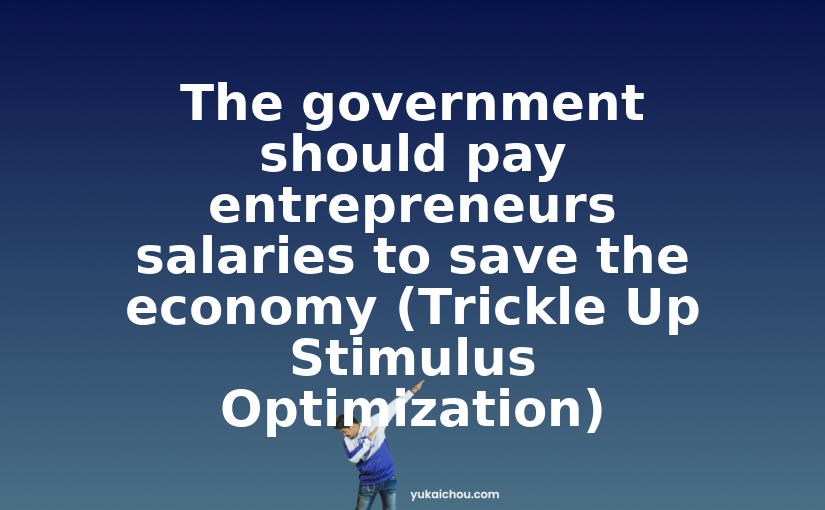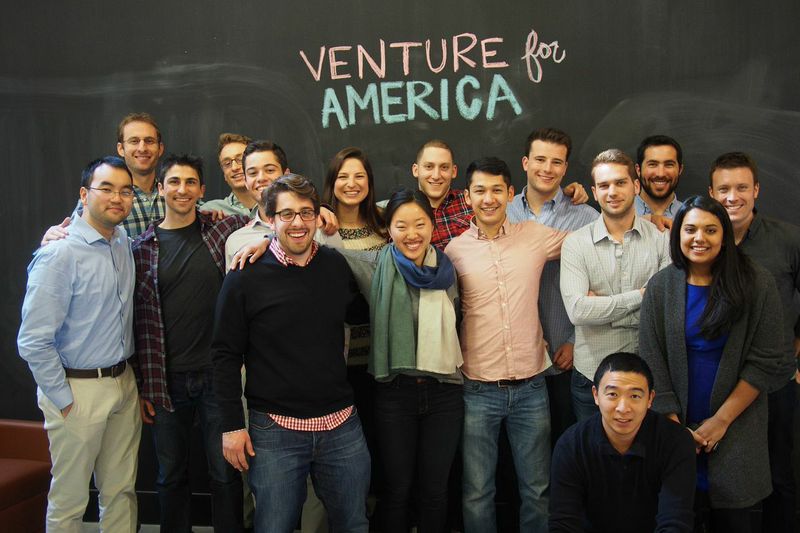(Note: this is a blogpost I originally wrote in 2009 during the financial crisis. In 2019 I became a supporter of Andrew Yang, and remembered that my proposal ten years ago, while not as “complete,” was very similar. So I updated it a little bit and surfaced it back. Despite having a degree in Economics, I am NOT an expert on the economy but an expert on behavioral design and gamification)
A few weeks ago, I was exercising while listening to the Wall Street Journal This Morning about what the government is doing to save the economy. I have also been paying attention to how governments are giving grants to startups who can prove that they are very innovative.
Having wrote a blogpost on this topic earlier, I formulated what I think is a doable plan for the government to save the economy.
For validation, I took this plan to two of my friends, one who is an ex-VC and Boston Consulting Group Consultant, and the other a Stanford University Researcher. They haven’t been able to poke holes in this theory *yet*, so I thought I would share it on my blog and hopefully I will find out the flaws in my thinking or it will get discovered by policy makers to really execute it through.
Foundations of my theory: nodes and 3 coefficients
When the government throws money into the economy, it passes through many “nodes” (person or organization), and each node has three coefficients along with it: spend/save, innovation, and upside.
This is using a tiny bit of my econometrics knowledge I obtained from my UCLA economics degree, but it should break down into fairly simple terms.
The Spend/Save Ratio (Coefficient) means when people get money, how much of it do they spend, and how much of it do they save up. If they save up all the money once they receive it, then the economy will not improve (unless it gets invested into another business that has high spend/save ratio).
In times of uncertainty, people who are fairly wealthy will save money. The only people that will spend are low income earners that can barely afford their own living. These people are forced to spend all the money they have each month, boosting the economy forward, especially if they pay others who are low in income too.
The SS Ratio is the deciding factor of how many “nodes” money passes through, making the other two coefficients more relevant.
The Innovation Coefficient is how much innovation is driven as $ passes through an entity. Like what most corporations argue, innovation does not just include creative ideas but also includes implementation and market adaption.
Some corporations spend hundreds of millions to launch an innovative product, while a startup creates a similar competing (sometimes better) solution after only spending one million dollars. The startup’s Innovation Coefficient is much higher as each dollar created more innovation.
Finally, the Upside Coefficient is how much more money can each dollar potentially generate if it goes well. The startup world knows this concept well. A Venture Capitalist would invest in ten startups that all have a potential upside of $100M. Most of them would fail, but it only takes one success to cover the rest and more. Now if the upside of the businesses were $10M, then investing $5M into ten businesses makes no sense. It would invest $50M in total, and only 1-2 companies would return $10M each while the rest would die.
The government needs to aim for a high upside value because their goal is to create thousands of jobs for each batch of money they throw into the economy.
Optimize government spending by maximizing all three values and make sure there are many nodes
Each dollar the government spends need to pass through as many nodes as possible with high coefficient values. So the formula pretty much goes: [$ * spend ratio * innovation * upside] for however many nodes there are until they all get saved up somewhere (and hopefully invested back into high Spend/Save Ratio entities in the US).
Money that goes to a large research corporation might have high innovation value (0.8 or 0.9), but the upside coefficient would be lower (you rarely see corporations that make a product that generates 50x the investment but it happens commonly in the startup world) and it will usually get saved up by high-paid engineers/scientists that are uncertain about the economy.
On the other hand, money that goes into a mom-and-pop stores will likely be all spent on covering costs, paying other low wage workers, and consumer spending at other mom-and-pop stores. There is still relatively low upside and innovation value to it though.
Pay entrepreneur salaries as a way to optimize economy recovery
Through this theory, my conclusion is that the best way to pump up an economy is to give grant-like salaries to sustain the lives of entrepreneurs (perhaps biased, but I sincerely think this is the best solution).
The government can give entrepreneurs a VERY low amount of survival money, like $20,000 a year, as a salary to do entrepreneurial work. This is useful because there are lots and lots of people who would be entrepreneurs but they couldn’t pursue their dreams due to realistic survival issues. They still have to raise their normal funding from investors and grow their business, but this plan allows them to pursue the innovation work they want without the fear of dying on the streets.
Many entrepreneurs are some of the smartest and most creative people in the workforce, and they demand very little to survive. They also need to spend all $20,000 of that money because they don’t have the capacity to save.
I tried it myself. $1200 a month is enough to cover subletting rent, cell phone bills, food money, $250 worth of monthly gas fees, and everything else I need. $20,000 a year is already a premium from that standpoint.
And that generates over 80-100 hours a week of productivity (I worked 100 hours a week for years without any pay). If an entrepreneur is running a startup just to have a comfortable materialistic life, he is in the wrong profession.
Entrepreneurs would also likely spend on other smaller and cheaper companies and employees that would need to spend most of their money too, passing through many nodes.
Their innovation value is obviously also very high. I would argue that each dollar spent in a startup is more efficient in terms of innovation compared to a large company because they all try to do things the leanest way without the bureaucracy costs.
Again, a great talent working 80-100 hours a week on an innovative concept with $20,000 a year. Am I missing something here or is this the best deal an economy could ever have?
Finally, and most importantly, the idea about startups is that if it works, it could make millions in revenue and create a lot more jobs. Startups don’t raise money so they can make enough cash-flow to sustain their own lives. They raise money in the promise that if it works, the money put in would return a hundred fold, creating new jobs, new markets, wealthy investors, and new happy entrepreneurs.
Low spending, high payout
So with this plan, with $2M the government could support 100 entrepreneurs for one year (not even talking about the billions that are spent elsewhere saving dying companies). And if you have a good VC talent in terms of screening which startups have potentials, you just have to play the numbers game and statistically 10 of these startups would become successful and generate millions of revenue with thousands of jobs.
Now imagine if the government spent $200 Million on that instead.
The beauty is that the other 90 entrepreneurs who fail hasn’t wasted the money either. They have produced some innovation in the economy, pushed forward valuable skill sets and experience in that field, and they would have spent all their money into circulation.
Again, keep in mind that, in this plan, it is obviously up to the entrepreneur herself to figure out how to raise money, find talents and all that to grow the business, but at least her survival to be an entrepreneur is covered.
Finally, this will definitely increase the entrepreneurial culture in the area. Entrepreneurs from other locations (if this is a city policy) might come just to apply for this program. It also encourages a lot of young talents to pursue this path right after college. Overall, it should be a win-win-win situation.
I truly believe that if the government implements this plan, there will be more spending, more innovation, and a lot more jobs created in the economy. Please help push this out to policy makers. I’m tired of this recession.
Update: I’ve received some criticism that this is like “welfare” for entrepreneurs and welfare is not efficent + the government should be hands off. I will argue that, in welfare systems, you pay people who are struggling to survive, and that’s it. In my plan, you are giving money to those who could create 1000 more jobs. One is more like a sympathy vote, whereas the other is more like investing into the future of the economy. I’d say if even 1% of the people the government supports on welfare can create 1000 more jobs, the economy would be MUCH MUCH better today.




